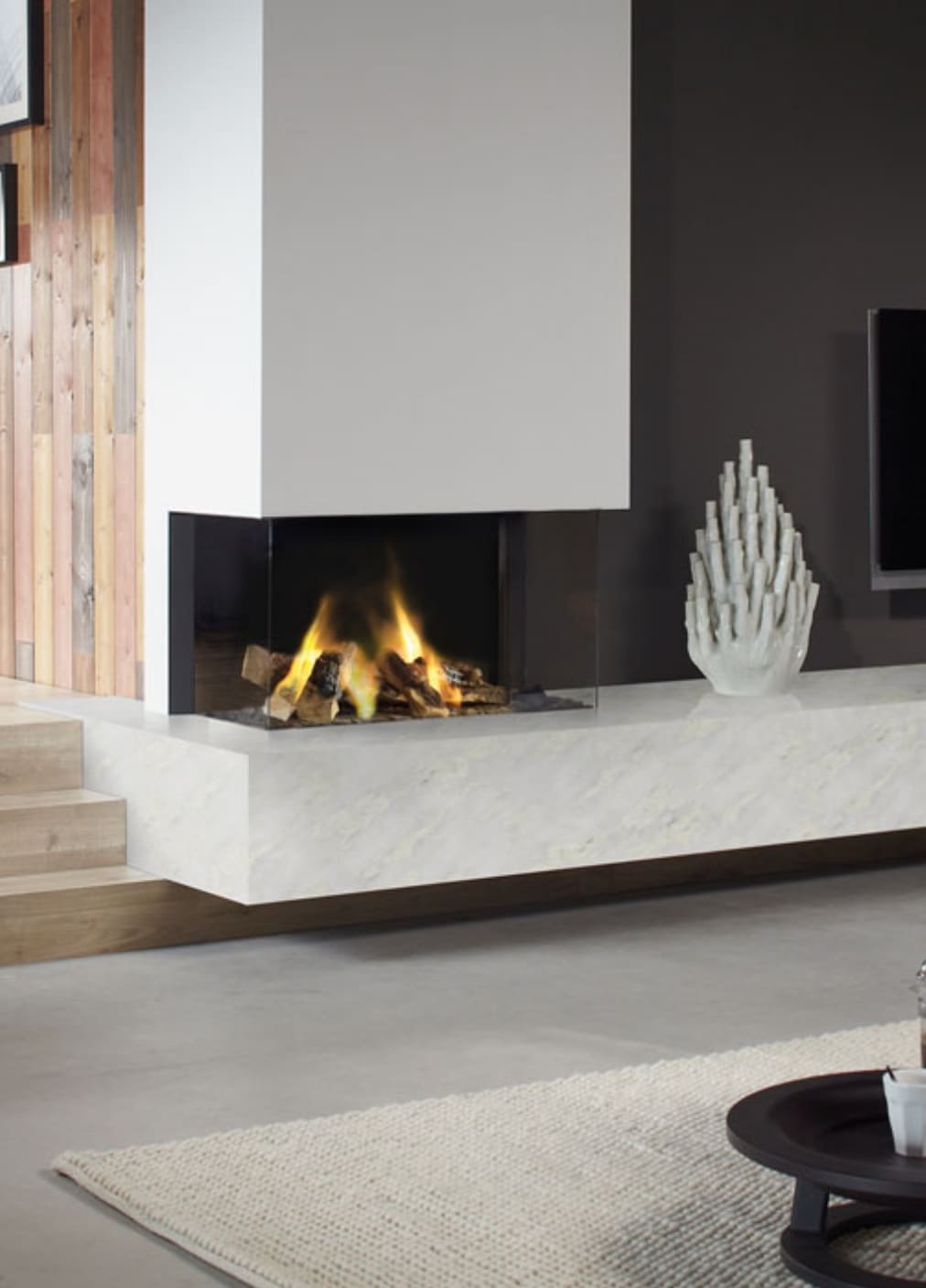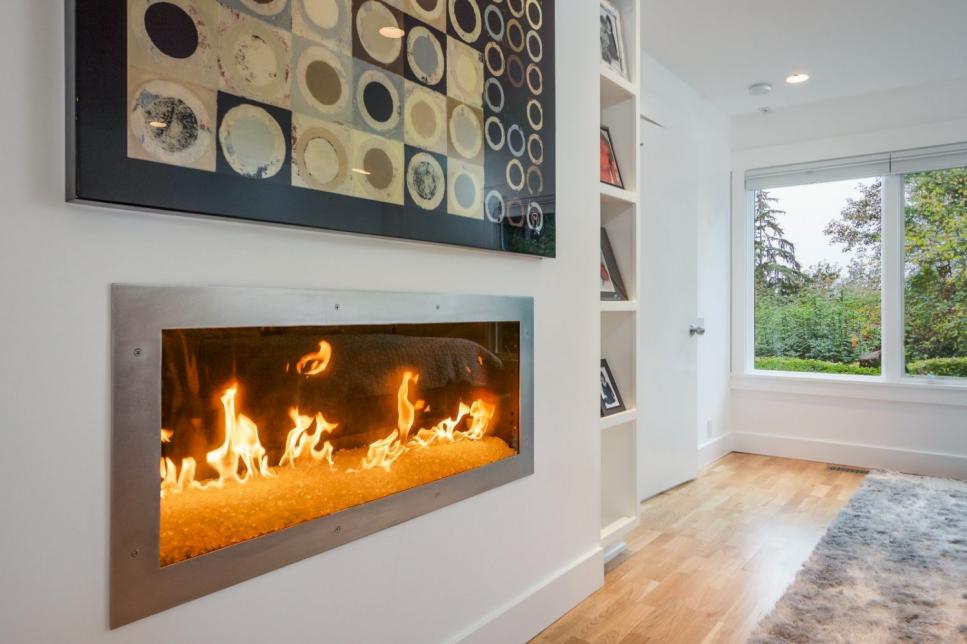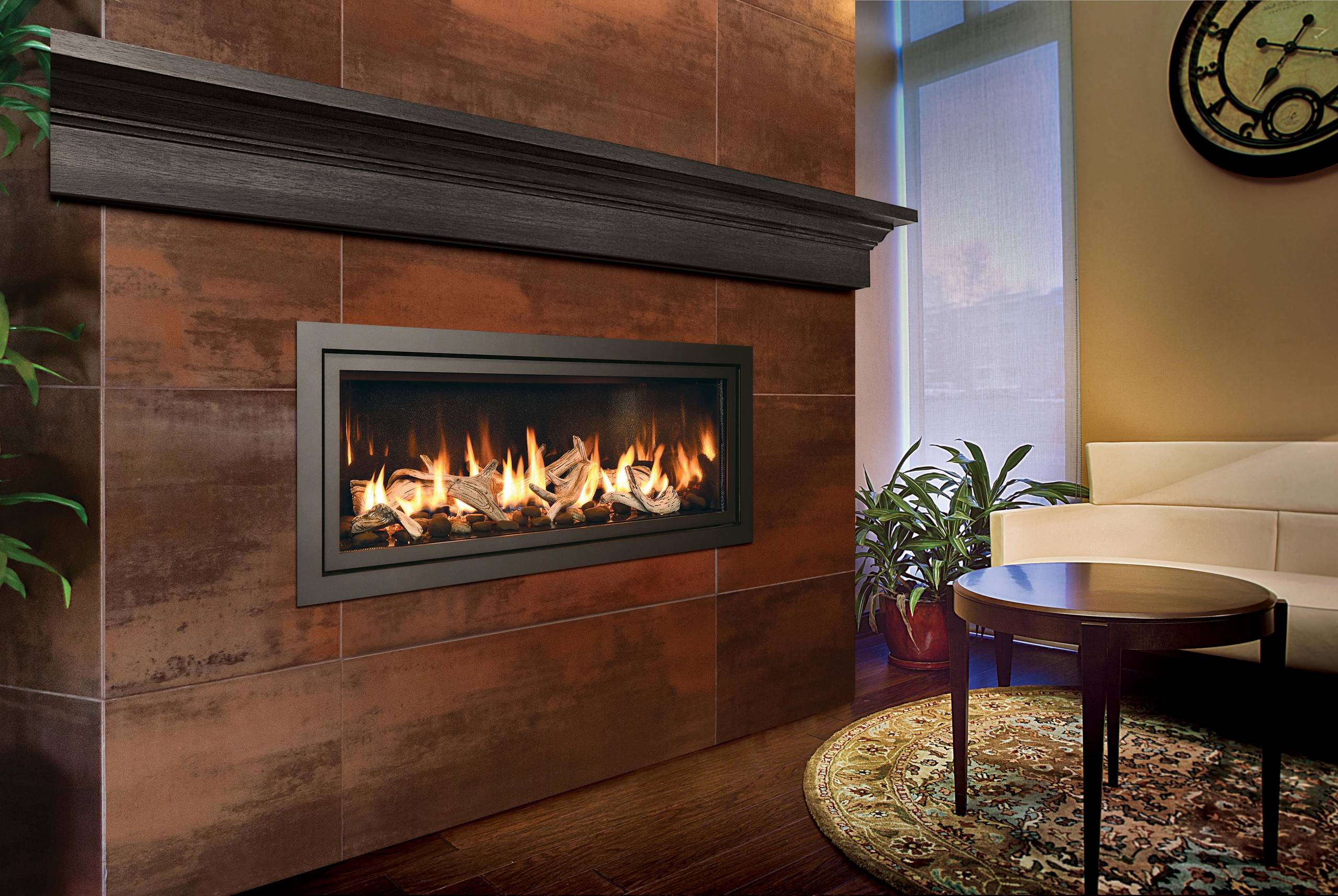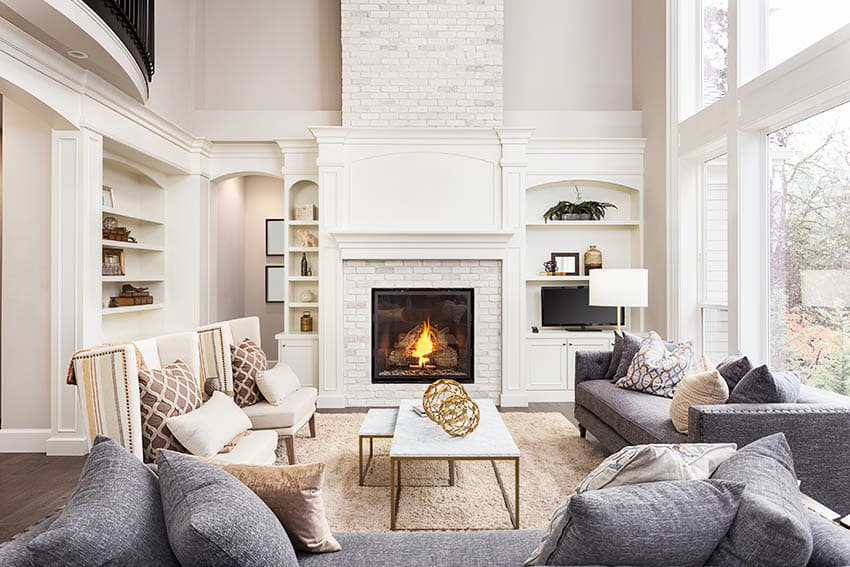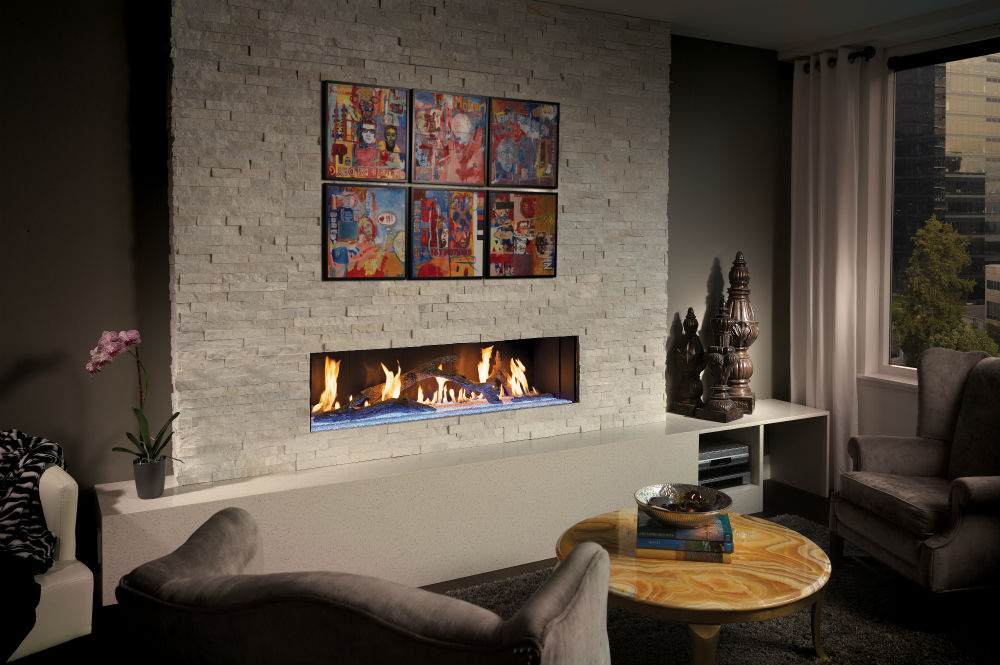As a designer who has worked with several clients to enhance their living spaces, I’ve witnessed firsthand how gas fireplaces can transform a room’s vibe. The subtle flicker of flames offers an instant focal point while providing efficient heat without the care required by traditional wood-burning choices. Contemporary gas fireplace designs combine technological innovation with aesthetic appeal, resulting in installations that match any interior style. Let me share what I’ve learned about designing attractive, effective gas fireplaces that strike the perfect balance between form and function.
Choosing Your Ideal Gas Fireplace Style
I always advise my clients that picking the proper style is the most important stage in any fireplace renovation. Contemporary linear designs with sleek, horizontal flame patterns look great in modern settings, producing clean lines and a minimalist appeal that feels smart without overwhelming the environment. Traditional types with log sets and larger flame patterns may be more suited to homes with traditional architecture, creating the warm, comfortable ambiance associated with family gatherings around the fireplace. For transitional areas, I typically recommend models that combine modern and classic characteristics, such as a classical surround with cleaner lines in the firebox itself.
When dealing with restricted square footage, I’ve discovered that wall-mounted units may be true game changers, saving valuable floor space while providing both heat and visual impact. Some of my smallest-footprint designs have become the most prominent features in their individual settings. Peninsula or see-through variants serve as spectacular room dividers, allowing the warmth and visual attractiveness to be experienced from various spaces at the same time, which is especially useful between living rooms and dining areas or between indoor and outdoor living spaces.
I’ve seen clients’ faces light up when they see their fireplace completed and realize how well it suits their concept, and it frequently becomes the feature that ties their entire design scheme together. This passion just strengthens my opinion that taking the time to experiment with many approaches before committing is crucial. I encourage homeowners to consider not only current trends but also their long-term contentment with the design, as a fireplace is often a long-term investment that should bring enjoyment for many years, regardless of changing design trends.
Materials and Surroundings That Make A Statement
I’ve discovered that the materials used to surround a gas fireplace have a significant impact on how it fits into your environment. Natural stone, such as limestone, marble, or slate, provides organic texture and timeless elegance, with each piece possessing distinctive veining or color variations that result in one-of-a-kind installations. In my projects with stone surrounds, I find that they age nicely, acquiring character over time and increasing their appeal. Metal surrounds in stainless steel, blackened steel, or brass provide contemporary sophistication and reflectivity, enhancing the visual impact of the fireplace while requiring little care.
Wood mantels and surrounds continue to be popular among clients looking for warmth and natural beauty, while I always urge sufficient clearances from the firebox to guarantee safety. I frequently propose combining materials to create unique designs, such as blending a sleek concrete hearth with a reclaimed wood mantel or contrasting polished marble with rough iron accents. This layering of materials adds visual depth to the fireplace, drawing attention and making it genuinely unique. Custom tile work provides limitless creative options, ranging from handcrafted ceramic pieces to glass mosaic patterns that capture light beautifully.
I recently finished a project with large-format porcelain tiles that looked exactly like Carrara marble but had better heat resistance and required substantially less care. The client was ecstatic about the aesthetic and practical benefits. When selecting materials, I always recommend taking into account the room’s current finishes, architectural style, and how the space is used, as these aspects should influence material choices. The most effective surrounds complement rather than compete with the room’s other design components, allowing the fireplace to function as a natural focal point.

Interior Design Integration Strategies
Each fireplace project is approached as an integrated part of the room’s overall composition, rather than a stand-alone feature. Coordinating the fireplace design with neighboring furniture configurations generates conversation areas that naturally attract people together, with seating positioned to take advantage of both the visual warmth of the flames and face-to-face connection. I’ve discovered that the most successful rooms have furniture layouts that recognize the fireplace as the anchor point while avoiding uncomfortable placing or traffic flow difficulties, allowing for natural movement across the area.
Color harmonization between the fireplace surround and the room’s palette creates a visual harmony that is both purposeful and elegant. I frequently use a secondary hue from elsewhere in the space for the fireplace surround or mantel, making subtle links that bind the design together without being overly matched. In open floor plans, I use the fireplace design as a unifying element that connects distinct functional zones, possibly repeating materials or colors used in both the kitchen and living spaces to provide visual continuity throughout the larger space.
When working with built-ins flanking a fireplace, I strike a careful balance between symmetry and utility, making sure that shelving meets practical storage and display requirements while keeping visual harmony. I recently created a system with flexible storage that could adapt to my clients’ demands while maintaining the overall architectural framework surrounding their linear gas fireplace. Lighting design is also important, with carefully placed accent lights highlighting textural features of stone or tile surrounds, as well as ambient lighting that complements rather than competes with the natural glow of the fireplace, resulting in layers of light that can be adjusted for different moods and occasions.
Technological Innovations to Consider
I’ve seen gas fireplace technology evolve dramatically in recent years, with options that considerably improve both functionality and enjoyment. Remote control systems have progressed from basic on/off switches to complex interfaces that allow for exact flame height adjustment, fan speed control, and even programmable scheduling. My clients really like being able to program their fireplaces to turn on shortly before they arrive home in the winter, greeting them with warmth and ambient light. Some models now work with smart home systems, allowing for voice control or remote operation via smartphone apps from anywhere.
Heat management technology have also advanced substantially, with zone heating capabilities that direct warmth where it is most required and heat transfer systems that may transport fireplace heat to neighboring rooms. For clients who are worried about efficiency, I offer direct vent versions that pull combustion air from the outside rather than using pre-heated inside air, which considerably improves total energy efficiency. These sealed combustion systems improve indoor air quality by keeping combustion byproducts from entering the living environment.
Realistic flame technology advances, with multidimensional burner systems producing dynamic, lifelike flames that are nearly indistinguishable from wood fires. High-definition ceramic fiber logs with exceptionally accurate bark textures and charring patterns round out the illusion. For contemporary installations, I frequently recommend media alternatives to typical logs, such as fire glass, ceramic stones, or geometric shapes that produce unique visual effects. LED accent lighting systems can improve the experience even more, with programmable colors that can vary to match the mood or complement seasonal décor, providing another dimension to the fireplace’s presence even when the flames are not lit.
Safety Features and Considerations
I make safety a priority in every fireplace design I develop, beginning with suitable ventilation systems that properly remove burning byproducts. Direct vent fireplaces with sealed combustion chambers offer good safety characteristics since the burning process is isolated from the indoor air. For families with children or pets, I usually advocate safety screens or glass barriers to prevent accidental contact with hot surfaces while yet allowing forthe visual pleasure of the flames. These barriers have advanced greatly from previous designs, with practically invisible mesh screens and frameless glass alternatives that maintain their aesthetic appeal.
Automatic shut-off features provide vital protection against potential gas leaks or flame failures by reducing the fuel supply as soon as abnormalities are detected. I ensure that clients comprehend these safety systems and identify their warning signals. Another important safety aspect is proper clearances from combustible materials, with minimum distances changing by model and influencing surround design possibilities. I work directly with experienced installers to ensure that all product requirements and local building codes are strictly followed, as shortcuts can pose major safety risks.
Carbon monoxide detectors around gas fireplace installations are an additional safety measure that I propose, regardless of local code requirements. I suggest that clients set up regular professional maintenance schedules, which typically include annual inspections to check for gas leaks, verify appropriate venting, and ensure all safety systems work properly. This preventive method aids in the early detection of potential problems. For retrofit installations in existing homes, I carefully assess the space for enough combustion air supply, venting options, and gas line capacity, addressing these fundamental requirements before moving on to attractive design features.
Environmental and efficiency considerations
I’ve noticed a growing interest among clients in the environmental impact of their heating options, with gas fireplaces providing various benefits worth considering. Gas fireplaces create much fewer particle emissions and no smoke than wood-burning alternatives, making them superior solutions for indoor and outdoor air quality. For ecologically sensitive clients, I recommend high-efficiency models with yearly fireplace efficiency ratings more than 70%, which extract the most heat from the fuel used while minimizing waste and lowering the overall carbon footprint as compared to older, less efficient units.
When building for energy efficiency, I carefully consider placement within the home, placing fireplaces where they will provide the most value in regularly used spaces rather than infrequently used formal rooms. Proper sizing is critical, as bigger units waste fuel and undersized units struggle to heat efficiently. To offer adequately sized models, I assess heating requirements using room dimensions, insulation levels, and climate zone. Zoned heating approaches enable gas fireplaces to augment central heating systems by concentrating warmth in occupied areas while minimizing energy use in empty rooms.
For clients pursuing green building certifications like as LEED or ENERGY STAR, I choose models with appropriate efficiency ratings that help them achieve their sustainability goals. Programmable thermostats and timers save needless operation by automatically adjusting output based on occupancy patterns or time of day. While not strictly renewable, natural gas and propane emit fewer greenhouse gases than energy generated by coal power plants in many areas. For those looking to reduce their environmental effect, I occasionally advocate bioethanol fireplaces as an alternative to regular gas types, however these often give more ambient than functional heating capability.
What is the usual cost for installing a bespoke gas fireplace?
The cost of a custom gas fireplace varies greatly depending on various things I discuss with each client. Basic insert installations may start around $3,000-5,000, but custom designs with quality materials and features often cost $8,000-15,000. The fireplace unit itself, venting requirements, surround materials, and any custom cabinetry or structural modifications that are required all have an impact on cost. High-end installations include premium stone surrounds, custom millwork, and smart home connectivity can cost more than $20,000. I always advocate setting aside roughly 15% of your budget to account for unexpected obstacles, especially in restoration projects where opening walls can uncover surprises. Remember that, while the initial cost may appear high, a well-designed gas fireplace adds tremendous value to your house while providing years of enjoyment and effective supplemental heating, which can balance some energy expenditures over time.
Can I convert my current wood-burning fireplace to gas?
I’ve walked countless clients through this popular conversion process, which provides a variety of options based on the condition of your current fireplace and aesthetic preferences. The simplest method is to install a gas log set in your existing firebox, which offers ambiance but produces little heat. Gas inserts that fit into your existing masonry aperture provide a sealed combustion chamber, which significantly increases heat production while reducing drafts. Complete retrofits involve replacing the complete fireplace structure with a new gas unit, which provides maximum design flexibility but necessitates more extensive construction work. Each option necessitates a professional evaluation of your existing chimney for optimal venting compatibility, as well as frequent changes to construct a gas line connection. I often find that conversions cost between 40-60% of new installs while retaining existing architectural aspects that many homeowners want to keep.
What kind of upkeep do gas fireplaces require?
I usually highlight that, while gas fireplaces require far less maintenance than wood-burning alternatives, they are not entirely maintenance-free, as some believe. Annual expert inspections are still required for safety and performance, and they normally cost between $100 and $200, depending on location. These inspections should include checking gas connections for leakage, ensuring adequate venting, cleaning the glass front, and verifying that all components work properly. Between professional visits, I recommend performing monthly visual checks of the flame pattern, which should be continuously blue with minimal yellow coloring. To remove film building that can interfere with flame visibility, clean the glass front on a regular basis with appropriate non-ammonia materials. Any fake logs or media should be checked annually for proper alignment in accordance with manufacturer specifications, since displaced components can degrade performance. Outdoor units require additional weather-related maintenance, such as protective covers in the off-season and more frequent checks of exposed components.
What are the most energy-efficient gas fireplace options?
Based on my experience developing high-performance systems, direct vent sealed combustion units routinely provide the highest efficiency among gas fireplace choices. These types use outside air for combustion rather than pre-heated indoor air, resulting in a completely sealed system with substantially lower heat loss. Look for models with electronic igniting systems rather than standing pilot lights, which can waste a significant amount of gas while the fireplace is not in use. Annual Fireplace Efficiency (AFE) ratings give standardized efficiency comparisons, with top performers receiving scores between 70 and 85 percent. Zone heating improves efficiency by directing heat where it is required rather than heating entire homes inefficiently. Programmable thermostats and remote controls with temperature management functions save energy by maintaining consistent comfort levels without requiring human adjustments. For best efficiency, I frequently recommend models with variable flame height control and fan systems, which assist spread heat throughout the room more effectively, allowing for lower settings while maintaining comfort.
How do I pick between conventional and contemporary fireplace designs?
I address this common topic by asking clients to evaluate both their home’s architectural style and their personal aesthetic tastes, as either can take precedence based on your goals. Traditional designs with genuine log sets and conventional proportions usually compliment older homes with classic architectural aspects such as crown molding or formal layouts. Contemporary linear fireplaces with minimalist surrounds and alternative media such as glass or stone complement modern interiors with clean lines and open floor layouts. Another significant indicator is your furniture style, as traditional rolled-arm sofas look well next to classic fireplace designs, but sleek, low-profile seating complements contemporary fires. Consider longevity, as fireplace installations can survive for decades, perhaps outlasting trendy design choices. For optimal flexibility, I occasionally advocate transitional designs that incorporate parts of both types, such as traditional proportions but cleaner surround features, allowing the room to adapt over time without the fireplace being old.
What do I need to know about gas fireplace venting options?
Understanding venting requirements is one of the most technical parts of gas fireplace design, with a substantial impact on both installation options and performance. Direct vent systems, which I normally propose, necessitate a sealed channel to exterior walls for both exhaust and intake air, ensuring indoor air quality while attaining high efficiency. These can vent horizontally through walls or vertically via roofs, providing versatility for placement around the home. Natural vent systems employ existing chimneys, which simplifies some conversions but usually results in lesser efficiency because they pull hot room air for burning. The most recent option, vent-free systems, require no exterior venting at all, increasing placement flexibility while raising issues about indoor air quality and moisture levels, making them inappropriate for some places, particularly beds or smaller rooms. Most towns have precise code requirements for authorized venting kinds and installation standards, which vary greatly depending on location and must be confirmed early in the planning process to avoid costly redesigns or constraints.
Gas Fireplace (Ultimate Design Guide) – Designing Idea
Direct Vent Gas Fireplaces – Sag Harbor Fireplace
Related Posts:

